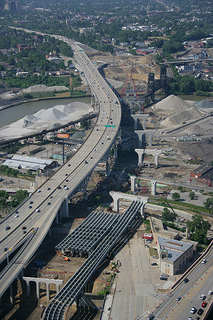In February 2009, the Ohio Department of Transportation (DOT) initiated the first of two projects designed to replace the aging steel truss bridge that carries Interstate 90 over the Cuyahoga River Valley and into Cleveland’s central business district. The first Innerbelt project, developing a new westbound bridge adjacent to the existing bridge, demonstrates how Ohio DOT is working to make its major transportation investments sustainable by reducing cost, maximizing benefits, and conserving resources.
Goals of the Program
The Innerbelt project team committed to achieving sustainability goals in seven categories, which have been dubbed the “Green 7.” These include:
- energy and energy efficiency;
- community environment;
- green building;
- waste reduction and recycling;
- green project administration;
- materials and resources; and
- construction practices.

Photo: Courtesy Innerbelt Bridge Photo Stream
ODOT’s Commitment to Sustainability
The Innerbelt project’s design and construction team found several ways to cut project costs while conserving resources and getting the bridge built faster. Progress toward achieving these goals is documented in Monthly Sustainability Summaries posted on the agency’s website. For example, as of Oct. 31, 2012, the agency reported the following achievements:
- Construction Vehicle Fuel Savings: By using construction vehicles with greater load-carrying capacity, the project has documented savings of over 85,000 gallons of diesel fuel.
- Carbon Emissions Reductions: By reducing the fuel usage during earthmoving, the project team has saved more than 1,074 metric tons of CO2 emissions.
- Materials Recycling: The demolition debris from the project is processed and sorted and more than half of all materials are recycled. The project team has recycled almost 5 million pounds of steel, preventing more than 123,000 cubic yards of waste from entering landfills.
- Smaller Bridge Footprint – By using a creative bridge design that featured a modified alignment from the one originally proposed, the project team was able to reduce the amount of earthwork needed during construction by about 35,000 cubic yards and decrease the amount of steel and other materials needed to build the bridge.
Other examples of sustainability on the project include construction of a pair of “pocket habitats” under the new span of the bridge. These areas allow growth of native plants and provide a safe haven for migrating fish. In addition, the project team is relocating Peregrine Falcons that made their home beneath the existing bridge.
Based on these and other attributes, Ohio DOT has used the Federal Highway Administration’s INVEST sustainability self-assessment tool to give the project a “gold” rating.
More information on the project, access Ohio DOT’s Innerbelt Bridge website and project sustainability page.

